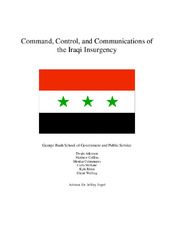| dc.contributor.advisor | Engel, Jeffrey A. | |
| dc.creator | Atkinson, Dwain | |
| dc.creator | Collins, Matthew | |
| dc.creator | Colmenares, Monica | |
| dc.creator | McBane, Carla | |
| dc.creator | Ritter, Kyle | |
| dc.creator | Welling, Glen | |
| dc.date.accessioned | 2011-07-21T19:34:59Z | |
| dc.date.available | 2011-07-21T19:34:59Z | |
| dc.date.issued | 2006 | |
| dc.identifier.uri | https://hdl.handle.net/1969.1/97035 | |
| dc.description | The Iraqi insurgency was formed by multiple nationalities and ethnicities with disparate goals and motivations. A central question to understanding the insurgency's unity is whether there is command and control, which is defined as the sharing of tactics, information, and skills. This capstone explored this question by investigating how insurgent groups in the past have managed to communicate and disseminate tactics, even while operating in a dangerous environment controlled by their more powerful adversary. The class then applied this historical lesson to the current situation in Iraq and examined whether the history of attacks indicated command and control in the Iraqi insurgency. | en |
| dc.description.sponsorship | The client for this capstone was Centra Technology, a private contracting firm specializing in technology and security services for private and government clients, including the Office of the Assistant Secretary for Infrastructure Protection, Department of Homeland Security, our contact for this project. | en |
| dc.title | Command and Control in the Iraqi Insurgency | en |
| dc.type | Other | en |
| dc.contributor.sponsor | Centra Technology | |


